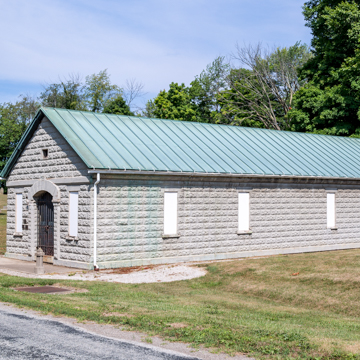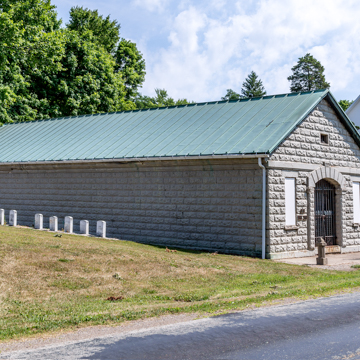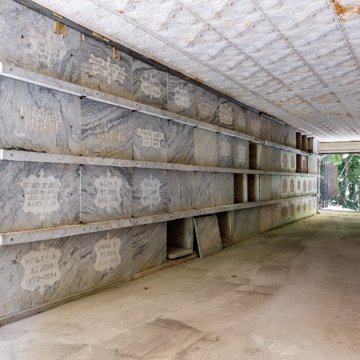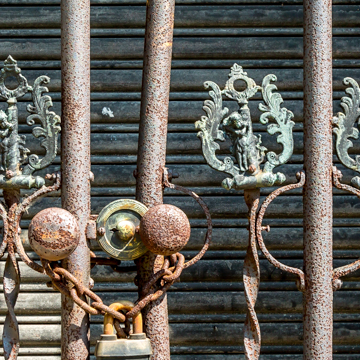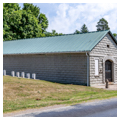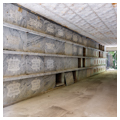When William I. Hood and his business partner, James Chesrown, introduced the modern compartment or community mausoleum in 1907, Ganges, Ohio, became the testing ground for a method of disposing of the dead that transformed American practices. They subsequently established the National/International Mausoleum Company, staking their claim to the idea as competing ventures sought to capitalize and expand upon it. Hood built this first community mausoleum with a concrete block exterior and substructure. Because the concrete block was susceptible to failure, by 1910 many community mausoleums were built with an exterior cladding of granite or limestone. Nonetheless, community mausoleums of the first generation did not withstand the test of time, either through poor maintenance or design flaws.
At Ganges, as was typical of mausoleums of this era, the interior crypts were overlaid with polished marble. It had stained glass windows and a mosaic tile floor and a clay tile roof. The Ganges mausoleum also contained front and rear access doors that allowed the funeral vehicle to enter the building from the front and exit the rear. Inside, sixty crypts are stacked five high on either side of a spacious center aisle that doubled as a chapel. Access to the mausoleum was controlled with keys presented to each crypt owner or their family members at the time of purchase. Only those possessing keys could gain entry to the mausoleum.
Compartment mausoleums were hailed as hallmarks of modern technology and as exemplary of progressive civic improvement. Obviously, the mausoleum was not a new idea; rather it combined a centuries old method of internment with modern building and engineering techniques. It also tapped into the American psyche as views of death, burial, and afterlife were evolving under pressure of religious tradition, demographics, and land use. Mausoleums were usually constructed in prominent locations, typically within or adjacent to the local cemetery, and they served as a focal point of the landscape, not unlike the elaborate above-ground memorials popularized by the rural cemeteries of the nineteenth century. In this sense, they also became status symbols for those who could afford them, a form of self-memorializing that blended ancient burial traditions and revivalist architecture. From the simple design of the Ganges Community Mausoleum, the building type grew increasingly elaborate, displaying classical and other revival architectural forms, as it spread across the nation. In addition, architects such as Cecil Bryan, Henry Siverts, and Sidney Lovell began to specialize in the design of community mausoleums.
Builders of the community mausoleum promoted them through direct mail and local newspapers, frequently featuring testimonials from civic leaders touting the buildings as civic amenities. Alternately, they were promoted as a way to bring scientific and sanitary body preservation to the masses. Such marketing techniques led to the widespread acceptance of the mausoleum. National shrines like the Abraham Lincoln Tomb in Springfield, Illinois, and the William McKinley Memorial in Canton, Ohio, also helped stimulate consumer interest in the compartment mausoleum, even if the local example—like the Ganges mausoleum—lacked the grandeur and awe of those designed to preserve the bodies of beloved national public figures.
References
Bryan, Cecil. Community Mausoleum. Chicago: Bryan, 1917.
Bryan, Cecil. “The Community Mausoleum.” Paper presented to the 43rd Annual Convention of American Association of Cemetery Superintendents, Los Angeles, California September 3, 4, 5, 6 and 7, 1929.
Bry, John. “The Better Way: The Community Mausoleum Movement in Indiana 1907-1934, A History and Preservation Considerations.” Master’s thesis, Ball State University, 2014.
Jackson, Kenneth. The Evolution of the American Cemetery. New York: Princeton Architecture Press, 1989.
Sloane, David. The Last Great Necessity. Baltimore: Johns Hopkins University Press, 1991.














